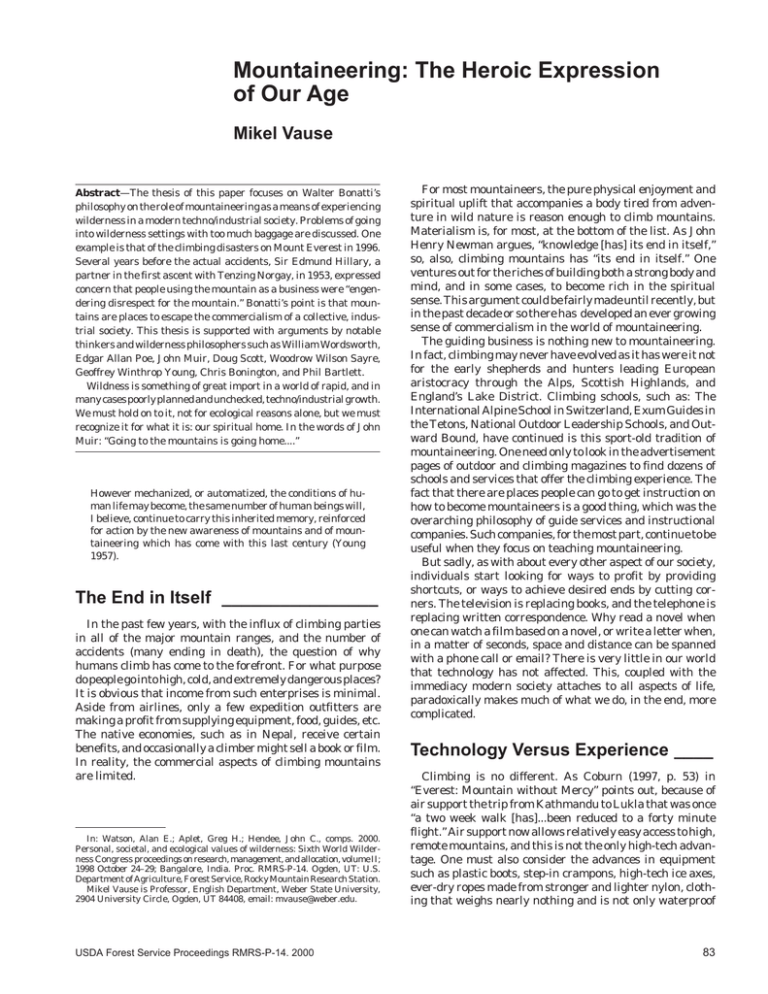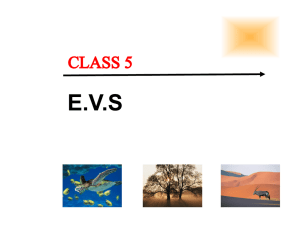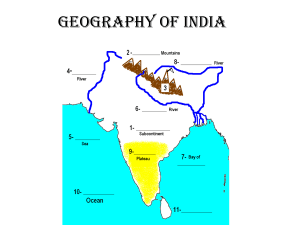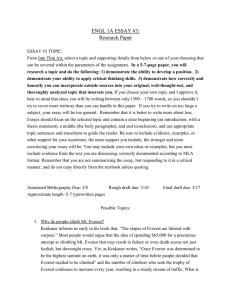Mountaineering: The Heroic Expression of Our Age Mikel Vause
advertisement

Mountaineering: The Heroic Expression of Our Age Mikel Vause Abstract—The thesis of this paper focuses on Walter Bonatti’s philosophy on the role of mountaineering as a means of experiencing wilderness in a modern techno/industrial society. Problems of going into wilderness settings with too much baggage are discussed. One example is that of the climbing disasters on Mount Everest in 1996. Several years before the actual accidents, Sir Edmund Hillary, a partner in the first ascent with Tenzing Norgay, in 1953, expressed concern that people using the mountain as a business were “engendering disrespect for the mountain.” Bonatti’s point is that mountains are places to escape the commercialism of a collective, industrial society. This thesis is supported with arguments by notable thinkers and wilderness philosophers such as William Wordsworth, Edgar Allan Poe, John Muir, Doug Scott, Woodrow Wilson Sayre, Geoffrey Winthrop Young, Chris Bonington, and Phil Bartlett. Wildness is something of great import in a world of rapid, and in many cases poorly planned and unchecked, techno/industrial growth. We must hold on to it, not for ecological reasons alone, but we must recognize it for what it is: our spiritual home. In the words of John Muir: “Going to the mountains is going home....” However mechanized, or automatized, the conditions of human life may become, the same number of human beings will, I believe, continue to carry this inherited memory, reinforced for action by the new awareness of mountains and of mountaineering which has come with this last century (Young 1957). The End in Itself ________________ In the past few years, with the influx of climbing parties in all of the major mountain ranges, and the number of accidents (many ending in death), the question of why humans climb has come to the forefront. For what purpose do people go into high, cold, and extremely dangerous places? It is obvious that income from such enterprises is minimal. Aside from airlines, only a few expedition outfitters are making a profit from supplying equipment, food, guides, etc. The native economies, such as in Nepal, receive certain benefits, and occasionally a climber might sell a book or film. In reality, the commercial aspects of climbing mountains are limited. In: Watson, Alan E.; Aplet, Greg H.; Hendee, John C., comps. 2000. Personal, societal, and ecological values of wilderness: Sixth World Wilderness Congress proceedings on research, management, and allocation, volume II; 1998 October 24–29; Bangalore, India. Proc. RMRS-P-14. Ogden, UT: U.S. Department of Agriculture, Forest Service, Rocky Mountain Research Station. Mikel Vause is Professor, English Department, Weber State University, 2904 University Circle, Ogden, UT 84408, email: mvause@weber.edu. USDA Forest Service Proceedings RMRS-P-14. 2000 For most mountaineers, the pure physical enjoyment and spiritual uplift that accompanies a body tired from adventure in wild nature is reason enough to climb mountains. Materialism is, for most, at the bottom of the list. As John Henry Newman argues, “knowledge [has] its end in itself,” so, also, climbing mountains has “its end in itself.” One ventures out for the riches of building both a strong body and mind, and in some cases, to become rich in the spiritual sense. This argument could be fairly made until recently, but in the past decade or so there has developed an ever growing sense of commercialism in the world of mountaineering. The guiding business is nothing new to mountaineering. In fact, climbing may never have evolved as it has were it not for the early shepherds and hunters leading European aristocracy through the Alps, Scottish Highlands, and England’s Lake District. Climbing schools, such as: The International Alpine School in Switzerland, Exum Guides in the Tetons, National Outdoor Leadership Schools, and Outward Bound, have continued is this sport-old tradition of mountaineering. One need only to look in the advertisement pages of outdoor and climbing magazines to find dozens of schools and services that offer the climbing experience. The fact that there are places people can go to get instruction on how to become mountaineers is a good thing, which was the overarching philosophy of guide services and instructional companies. Such companies, for the most part, continue to be useful when they focus on teaching mountaineering. But sadly, as with about every other aspect of our society, individuals start looking for ways to profit by providing shortcuts, or ways to achieve desired ends by cutting corners. The television is replacing books, and the telephone is replacing written correspondence. Why read a novel when one can watch a film based on a novel, or write a letter when, in a matter of seconds, space and distance can be spanned with a phone call or email? There is very little in our world that technology has not affected. This, coupled with the immediacy modern society attaches to all aspects of life, paradoxically makes much of what we do, in the end, more complicated. Technology Versus Experience ____ Climbing is no different. As Coburn (1997, p. 53) in “Everest: Mountain without Mercy” points out, because of air support the trip from Kathmandu to Lukla that was once “a two week walk [has]...been reduced to a forty minute flight.” Air support now allows relatively easy access to high, remote mountains, and this is not the only high-tech advantage. One must also consider the advances in equipment such as plastic boots, step-in crampons, high-tech ice axes, ever-dry ropes made from stronger and lighter nylon, clothing that weighs nearly nothing and is not only waterproof 83 but breathable, light-weight stoves, and freeze-dried food; the list goes on and on. Yet with these many improvements intended to make the activity more safe, and certainly more comfortable, why are people climbing big mountains and dying at such alarming rates? Part of the problem has to do with why they are on the mountain in the first place. Are they there for intrinsic reasons, for example, personal physical challenge, or mental and spiritual elevation? Or are they climbing because high adventure is in vogue and they have some disposable income? It is commonly held that one can do anything with money. When it comes to climbing, many believe that because they can hire an experienced guide and are able to purchase the latest Goretex clothing and the most up to date climbing hardware, they will be safe. By taking on the role of client, they have purchased protection without paying the “real” dues that come from personal experience. According to Peter Athans, a professional Everest guide: “Occasionally you’ll get a client who thinks he’s bought a guaranteed ticket to the summit” (Krakauer 1997, p. 23). The truth is that no amount of expensive equipment, or the fact that one is part of a guided party, can substitute for experience. In order to perform in difficult situations one must be prepared, and preparation comes from experience. Apprenticeship _________________ In the climbing community in which I grew up, there was a core group of climbers who served as mentors to almost all the beginning climbers in the area. It was nearly impossible to start a climbing career without having some contact with members of that group. It was a friendly time, and new climbers were welcomed as long as they wanted to learn proper climbing techniques. One served an informal apprenticeship by climbing with more experienced climbers. After one had learned rope handling, proper belaying techniques, and how all the equipment worked on short top roped climbs, the new climber was ready to serve as a second and participate in multi-pitch climbs. (Admittedly it wasn’t all that hard to figure out how to drive and remove pitons; today’s equipment is a bit more technical and takes more practice to use.) After a period of participation as a second, the opportunity to lead came. By today’s standards this process seems long and drawn out, but looking back I remember very few accidents, and a fatality was extremely rare. Part of the problem today is impatience. Immediate Gratification __________ We live in a world that has come to expect immediate gratification on all fronts. Everything one wants in life must be immediately available. In the 1990’s it is almost unheard of for a young person to save money to buy a car. Why should one have to wait when they can simply take out a loan. One can hardly walk across a college campus in America without being confronted by numerous opportunities to apply for credit cards. This have-it-now philosophy easily transfers to all other aspects of society. There can be no question that in many ways the amazing technological advances of the twentieth century have made life better, but in some ways it has made life more dangerous because it provides opportunities 84 too easily and without requiring proper preparations. The disasters on Everest in 1996 drives this point home. In an attempt to “unite vocation and avocation,” climbing guides like Rob Hall, Scott Fischer, and others somewhat unwittingly diminished the dangers of climbing a mountain the size and immensity of Everest. In an attempt to make a living doing what they loved to do they allowed people who had no business being on Everest, due to lack of experience and preparation, who hadn’t paid their dues so to speak, to not only endanger themselves, but put the lives of other climbers on the mountain, the guides in particular, in jeopardy. According to Sir Edmund Hillary, the first to successfully reach the Everest summit in 1953, ventures such as Hall’s and Fischer’s are “engendering disrespect for the mountain” (Krakauer 1997, p. 66). Krakauer provides a vivid illustration as he recounts a conversation with Scott Fisher: A few weeks after Fischer returned victorious from Everest in 1994, I encountered him in Seattle. I didn’t know him well, but we had some friends in common and often ran into each other at the crags or at climbers’ parties. On this occasion he buttonholed me to talk about the guided Everest expedition he was planning: I should come along, he cajoled, and write an article about the climb for “Outside” (magazine). When I replied that it would be crazy for someone with my limited high-altitude experience to attempt Everest, he said, “Hey, experience is overrated. It’s not the altitude that’s important, it’s your attitude, bro. You’ll do fine. You’ve done some pretty slick climbs—stuff harder than Everest. We’ve got the big E figured out, we’ve got it totally wired. These days, I’m telling you, we’ve built a yellow brick road to the summit” (Krakauer 1997, p. 66). Such statements as those attributed to Scott Fischer are not only deceptive but extremely dangerous. As all mountaineers know, the complexion of a mountain can change from moment to moment. In a recent conversation with Doug Scott, who reached the summit of Everest via the Southwest Face in 1976, the point was made that if one signs onto a guided expedition to Everest they should be sure they have purchased a round-trip ticket. “...We’ve built a yellow brick road to the summit,” but what about getting down from the summit alive? Apparently there were some in 1996 who, unfortunately, only had a one-way ticket. This essay is not meant to be an attack on Rob Hall, Scott Fisher, or any other mountain guide, but it does raise questions about the “materialistic premises” creeping into mountaineering, which is the concern Bonatti (1974) addresses in his essay, “Mountaineering.” In Bonatti’s essay one finds one of the best examinations of why humans climb mountains. The essay “Mountaineering” provides a careful examination of the role of the mountaineer in the modern era, dominated by technology and industry. Because mountaineering is basically a romantic (intrinsic) pursuit, it seems to be at odds with the basic philosophies that govern a (extrinsic) techno-industrial society where material gain equates with success. The article deals with the age old, archetypical conflict between the spiritual and the physical. Many mountaineers find that time spent in the mountains brings them to elevated inner feelings, sometime revelatory, sometimes insightful or reflective, as the result of direct contact with wild nature, or nature in a relatively unmolested state—free from the harmful by-products of human over-involvement. USDA Forest Service Proceedings RMRS-P-14. 2000 Philosophical Considerations _____ It is clear in romantic philosophy (whether it be the ancient eastern philosophers of Buddhism, Taoism, or Hinduism, or the more modern western philosophers such as the German romantics Goethe and Schiller, the English romantics Blake, Wordsworth, and Coleridge, or the Americans Emerson, Thoreau, and Whitman) that humans, if left to the influences of the unspoiled natural world, will in fact, elevate themselves to an almost divine state through repeated contact with the workings of the natural world. Humans learn best by first-hand experience. In the words of Ann Zwinger, “there is no substitute for blisters and sunburn” (Trimble 1989, p. 9). Bonatti’s philosophy agrees with that of Zwinger as he explains that to venture into the mountains is a natural human desire. He, in fact, argues that testing oneself against the mountain is “a way of expressing man’s ancestral dialogue of love with mother nature in terms of action” (Bonatti 1974, p. 71). Bonatti, the romantic, goes on to lament the loss of past values, particularly those placed on mystery and heros. He says, “Daily living has become a round of demands, provocations, and doubts. The intellect sweeps away spiritual values even before they are formed. Deprived of standards in a decadent society where nothing is fixed or defined, heroism has leaked away for sheer lack of purpose.” Edgar Allan Poe (1966) expresses the same concern in the poem “Sonnet To Science:” Science! True daughter of Old Time thou art! Who alterest all things with thy peering eyes. Why preyest thou thus upon the poet’s heart, Vulture, whose wings are dull realities? How should he love thee? Or how deem thee wise, Who would not leave him in his wandering To seek for treasure in the jeweled skies, Albeit he soared with undaunted wing? Hast thou not dragged Diana from her car? And driven the Hamadryad from the wood To seek a shelter in some happier star? Hast thou not torn the Naiad from her flood, The Elfin from the green grass, and from me The summer dream beneath the tamarind tree? Bonatti sees the mountaineer as taking up the role of hero in a time when the human spirit needs a new champion who, through physical action and spiritual elevation, leads a rebellion against “the frustrations of industrial civilization, rebellion against a collective society, a society almost happy to sink into a general mediocrity, and always content to seem rather than be. It is also a rebuttal of disillusion and ignobility and of that security offered as progress, which, when achieved, makes spiritual progress impossible” (Bonatti 1974, p. 72). To the romantics, a techno-society is evil as it entices people, through the glorification of the material, to divorce themselves from nature. There is an obvious danger in the invitation of industry for people to leave the pastoral settings such as small villages and farms, where they are in constant contact with harmonious workings of nature, for the large industrial urban centers made up of row houses and factories. In the pastoral setting, currency is much less important than in urban settings because much of what is USDA Forest Service Proceedings RMRS-P-14. 2000 necessary for existence is produced through an active partnership with nature—tilling the land, planting seed, tending the garden, and reaping the harvest. Whereas, in the urban setting of the industrial community, one receives wages for working in the factories; it is necessary to purchase life’s necessities from vendors, thus eliminating firsthand participation in the harmonious natural process. As Wordsworth (1990, lines 179-200) states in his poem, “The Old Cumberland Beggar:” May never HOUSE, misnamed INDUSTRY, Make him captive!—for that pent up din, Those life-consuming sounds that clog the air, Be his natural silence of old age! Let him be free of mountains solitudes; And have around him, whether heard or not, The pleasant melody of woodland birds... As in the eye of Nature he has lived, So in the eye of Nature let him die! Emerson suspects that humans are the only animals not in harmony with the natural world and that human disharmony is learned, not innate. Such a philosophy is in direct conflict with the old puritan standards of Emerson’s time that argued humans are born degenerate as a result of the fall of Adam. Emerson sees in most humans an innate goodness that gets replaced with learned disharmony, and they are, therefore, further removed from the natural world and its spiritual by-products. Emerson goes on to argue that humans can, in fact, but only through frequent contact with wild nature, actually unite what he called the “ideal and the actual,” and thus bring together the physical and spiritual to create a harmonious existence. This same idea is paramount in Scott’s (1991) essay, titled “On the Profundity Trail,” in which he argues that going into remote places (places that take commitment to visit) enables him to recharge his spiritual batteries, and when he returns to the social world he is better prepared to contribute to its betterment. In recounting his ascent of the Salathe Wall, Scott states: “...after the trip I did seem to know positively where to go next—and that was back into society, relaxed, but with a new zest and enthusiasm....” He goes on to explain that the more commitment it takes to complete the journey the greater the reward: If big wall climbing is pursued in a more hostile environment and for longer periods, if the big wall climber climbs alone, as Bonatti did on the Dru, then the doors of perception will be opened wide. The climber involved may experience a more lasting state of heightened awareness, and may even reach a truly visionary, if not mystical, state of being which transcends normal human comprehension.... The climber who is willing to extend himself to the limit of his technical skill and endurance on any long climb, is en route up the profundity trail (Vause 1993, p. 110). Who Should Be on Everest and Why _______________________ Returning to the idea of novice climbers on Mount Everest, it should be noted that even though both Bonatti and Scott speak of committing oneself to the “limits of technical skill and endurance,” the point should also be made that one must 85 know, and be realistic, about one’s limitations. Spiritual and intellectual enlightenment does little good if one is dead and unable to share it with others. So why climb? The argument has been made that to do so for material reasons can, in many cases, only lead to disaster as was the case on Everest in 1996. Ironically, it was those with the most experience that were killed in an effort to meet their obligations to paying clients. Wilford Noyce, a member of the successful 1953 British Everest Expedition said, “...we go out because it is our nature to go out” (Vause 1993, p. 10). Anderson (1970), in his work, “The Ulysses Factor,” states it is a natural human instinct to explore—to seek adventure. The philosopher Sayre (1964) led a four-man expedition to the north side of Mount Everest in 1962 and recorded the adventure in the book “Four Against Everest.” In this most interesting expedition account, he discusses several reasons humans climb: “the question about climbing is not a question about motivation at all....it is really a question about relative values.” One value is that of beauty: “If a person will cross the ocean just to look at the beauty of a cathedral, why would he not do as much or more to see sights such as these [speaking of the Himalayas]” (Sayre 1964, p. 204). Sayre goes on to say that there is a reason greater than to view beauty, but it is directly connected to beauty: Very closely assisted with the beauty of the mountains are some special emotions which the highest and wildest peaks provoke. I feel a special excitement when I look out over thousands of square miles of untouched country. I feel it again when I walk where only a handful of men have walked in the history of the world, when I explore some hidden ridge or crag, or when I make the first track across a great unbroken snow field. I feel a special happiness to be alone in the high, silent places of the world tucked close under the sky. Such things are worth a little insecurity and sacrifice (Sayre 1964, p. 204). Just as Bonatti and Scott, Sayre loves his time in wild solitude, but he also recognizes the need for contact with others of his kind: We need to experience nature with friendly marks upon it of human works and struggle and hope. But also we need to see nature apart from even the smallest sign of human interference. For this the high mountains are perfect (Sayre 1964, p. 208). Bartlett, a mountaineer and author of “The Undiscovered Country,” sees the need for humans to return to their primitive roots and that going into the mountains is a means to that end. He points out, “A return to the primitive encourages a mental retrenchment in which the forgotten elements of life regain their rightful status....the attraction of the primitive life is that it takes one away from these pressures [Bonatti’s industrial, collective society] which make it impossible to feel psychologically free” (Bartlett 1993, p. 71). One of the ways this whole process comes about, according to Bonatti, is that mountaineering is a natural “next step” for 86 people who live around mountains. Referring to early mountaineers, Bonatti states that after they had explored the valleys and passes they “felt the urge to conquer the summits” (Bonatti 1974, p. 71). As the routes to the summits became harder and more technical Bonatti states, “Mountaineering really transcended its origins, assuming an almost philosophical significance. I would say that it acquired a soul, and from there went on to become an active and heroic expression of our age” (Bonatti 1974, p. 71). That expression is the escape from the doldrums of collective society and the freedom and elevation of the human spirit coming from contact with wild nature. Bonatti continues: Knowledge and wisdom are both essential to human progress, but they are not the same thing, as philosophy has long reminded us. However, let us accept our so called social conquests; let us disembark on the moon and other planets in our insatiable pride; only let us not forget that the destiny of man is to become ever more human. That is what the wise, useless, ‘mad actions’ of our present-day heroes are meant to remind us (p. 73). What is the purpose of mountaineering? To gain in things material? No. The purpose is as stated by John Muir, the nineteenth century American mountaineer: Climb the mountains and get their good tidings. Nature’s peace will flow into you as sunshine flows into trees. The winds will blow their own freshness into you, and the storms their energy, while cares will drop off like autumn leaves” (Muir 1979). References _____________________ Anderson, J. R. L. 1970. The Ulysses factor. New York: Harcourt Brace Jovanovich, Inc. 259 p. Bartlett, Phil. 1993. The undiscovered country. London: The Ernest Press. 183 p. Bonatti, Walter. 1974. The great days. Tr. Geoffrey Sutton. London: Victor Gollancz Ltd. 189 p. Coburn, Broughton. 1997. Everest: mountain without mercy. Washington, DC: The National Geographic Society. 256 p. Krakauer, Jon. 1997. Into thin air. New York: Villard. 292 p. Muir, John. 1979. John of the mountains: the unpublished journals of John Muir. Ed. Linnie Marsh Wolfe. Madison, WI: University of Wisconsin Press. 459 p. Poe, Edgar Allan. 1966. The complete stories and poems of Edgar Allan Poe. New York, NY: Doubleday. 821 p. Sayre, Woodrow Wilson. 1964. Four against Everest. Englewood Cliffs, NJ: Prentice-Hall. 284 p. Scott, Doug. 1971. On the profundity trail. Mountain. 15: 12-17. Trimble, Stephen. 1989. Words from the land. Layton, UT: Gibbs M. Smith Books. 303 p. Vause, Mikel. 1993. On mountains and mountaineers. LaCrescenta, CA: Mountain ‘N Air Books. 119 p. Wordsworth, William. 1990. Poetical works. Oxford: Oxford University Press. 777 p. Young, Geoffrey Winthrop. 1957. The effects of mountains upon the development of human intelligence. Glasgow, Scotland: Jackson, Son & Company. 30 p. USDA Forest Service Proceedings RMRS-P-14. 2000







